Tags
How many of you are anxious about tomorrow? I feel like a kid waiting for the first day of school to begin. I don’t think I’ll be able to sleep tonight.
Tuesday morning, the New Horizons spacecraft will make its closest – and first ever! – approach to Pluto, an icy world that’s almost five billion miles away from Earth. We’ve been seeing picture after picture of the dwarf planet, each image becoming clearer than the last.
This is some groundbreaking stuff. Above, we see Pluto and its largest moon, Charon. That’s quite the difference from the photo we posted only days ago.
Below, we see more of Pluto’s features, including what could be cliffs and an impact crater.
We’ve also learned that the dwarf planet is larger than we expected it to be. At 1,473 miles in diameter, “Pluto is larger than all other known solar system objects beyond the orbit of Neptune,” according to a NASA release.
The New Horizons spacecraft will zip by Pluto at an incredible 30,800 miles per hour tomorrow. But we won’t hear from the unmanned spacecraft until much later. Check out this Pluto in a minute feature and find out why:
Don’t forget to watch the Science Channel and NASA TV for updates throughout the day. We’ll also be tweeting, so feel free to follow. And share! 🙂


